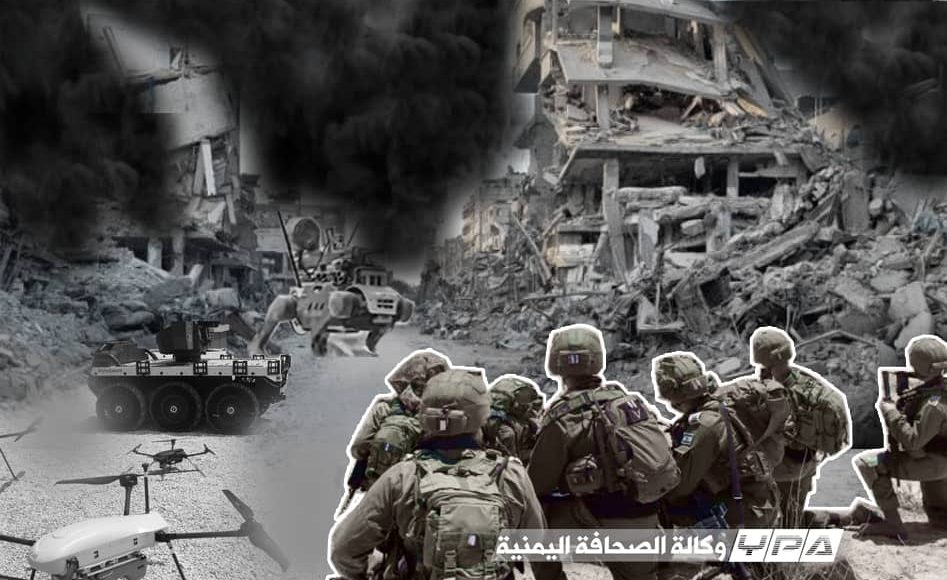GAZA, Sept. 30 (YPA) – Concerns are escalating in Gaza City over the Israeli occupation army’s alleged use of unprecedented military tactics, most notably “booby-trapped robots” and “fire belts,” which have reportedly transformed densely populated neighborhoods into scenes of total destruction.
Human rights and medical groups warn that these are tools of genocide targeting over 800,000 civilians living in extremely confined geographic areas.
The fears stem from the Israeli occupation army’s reliance on these tactics, which human rights and medical organizations have described as instruments of genocide, going beyond traditional combat methods.
“Barrels of Death”: The Booby-Trapped Robots
According to field and rights reports, the Israeli army has developed a new mechanism involving remotely operated, explosives-laden vehicles used as mobile barrel bombs.
Gaza residents have dubbed these vehicles the “booby-trapped robots.” They are driven into residential neighborhoods and then detonated instantly, leveling entire buildings and dismembering the bodies of those inside.
Munir Al-Bursh, Director General of the Ministry of Health in Gaza, stated that the occupation has begun to rely daily on these explosive robots within the city, claiming that each robot can carry up to seven tons of high explosives, and the army operates between 7 to 10 robots daily in different neighborhoods.
Al-Bursh added that these tactics have forced thousands of families to flee west, driving population density to an unprecedented 60,000 inhabitants per square kilometer, which multiplies humanitarian risks.
The first documented use of the robots, by rights groups, was during the invasion of the Jabalia Camp last May, where an Israeli APC was discovered entering homes before exploding, causing massive destruction and dozens of casualties. It was later determined that it was not a traditional troop carrier but a robot loaded with explosive barrels.
Fire Belts Devour Neighborhoods
In parallel with the booby-trapped robots, the Israeli army has intensified its use of what is militarily known as “fire belts” in recent months. This tactic involves successive aerial and missile bombardment of entire residential blocks, turning the targeted area into a theater of total devastation within minutes.
Local media sources have documented the implementation of fire belts in neighborhoods including Sheikh Radwan, Al-Nasr, Al-Nafaq, Al-Daraj, and Tal Al-Hawa, in addition to Al-Shuja’iyya and Al-Tuffah in eastern Gaza, extending to Khan Younis and Beit Lahia.
Images show the simultaneous and intense nature of the raids, executed either longitudinally from north to south, circularly to impose a fire siege on a specific area, or zig-zaggedly to target fortifications and residential areas at the same time.
Historically, the roots of this method trace back to World War II when the German army relied on shelling Warsaw to force its inhabitants to flee. In Gaza, researchers suggest the goal is no longer just evacuation, but achieving the maximum amount of destruction and human loss as part of a scorched-earth policy.
Eyewitness Accounts and Damning Evidence
Medics and residents described to local media massive explosions that instantly blew out the facades of multi-story buildings.
A survivor from the Al-Sabra neighborhood described the scene, stating: “It was as if the ground split open. A small vehicle drove between the houses, and suddenly the streets turned into a huge crater, and people were shredded into fragments.”
Human rights organizations, including the Euro-Mediterranean Human Rights Monitor, published photos and video clips showing booby-trapped robots entering residential areas and then exploding in a manner whose devastating effect resembles that of vacuum bombs.
The organizations confirmed that these weapons have caused civilians’ bodies to be shattered to the point of disintegration.
Catastrophic Humanitarian Impact
The escalating use of these military tactics has directly impacted civilian life:
Mass Displacement: Tens of thousands have been forced to leave their homes and crowd into western areas deemed “safer,” though they too remain under fire.
Health Collapse: The number of injured and dead is rising amid the diminishing capacity of hospitals, which face being put out of service due to siege and supply shortages.
Exacerbated Population Density: The density has reached what are considered the highest levels globally, multiplying the risks of disease spread and famine.
Legal and Ethical Controversy
International human rights organizations, including Human Rights Watch and Amnesty International, emphasize that International Humanitarian Law mandates the principle of distinction between civilians and combatants and prohibits attacks that cause disproportionate civilian harm. The use of booby-trapped robots or fire belts in densely populated areas is categorized as a war crime.
International law expert Michael Lynch explained to a British newspaper that remote control does not absolve responsibility but rather increases the suspicion of premeditated intent to target civilians, as the operator is fully aware of where and in what environment the weapon is being detonated.
Unconventional Weapons in a War of Annihilation
While Israeli Prime Minister Benjamin Netanyahu boasts about his army’s ability to erase entire neighborhoods, the reality on the ground remains grim: remotely detonated robots inside cities, fire belts reducing neighborhoods to ruins, and hundreds of thousands of civilians trapped between death and displacement.
This pattern of weapons and tactics, according to international institutions and organizations, amounts to a systematic policy aimed at emptying Gaza of its inhabitants through gradual tools of genocide.
In conclusion, the international community, human rights organizations, and international courts face a stark test: either urgent action to stop the use of these devastating weapons against civilians or leaving Gaza to face a 21st-century “Warsaw” scenario alone.
YPA


